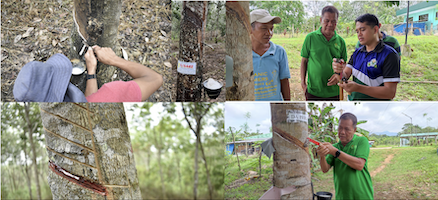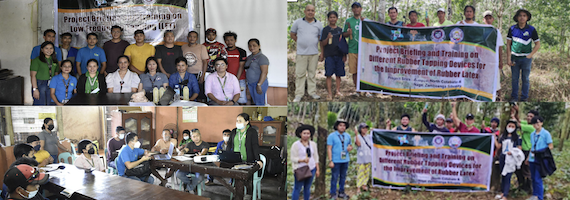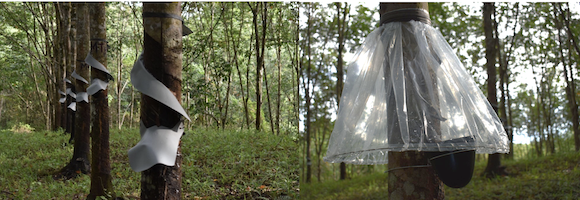 The Philippines is the 12th among natural rubber producing countries in the world and has contributed about 0.77% of the world’s natural rubber production (ANRPC, 2020). To reap the potential of the rubber industry in poverty alleviation, efficient and sustainable rubber latex harvesting practices should be available to farmers.
The Philippines is the 12th among natural rubber producing countries in the world and has contributed about 0.77% of the world’s natural rubber production (ANRPC, 2020). To reap the potential of the rubber industry in poverty alleviation, efficient and sustainable rubber latex harvesting practices should be available to farmers.
Rubber tapping to collect latex is a crucial process because poor practices could result in low yield, reduction of productive life of rubber, and increased susceptibility to pests.
With the aim of improving rubber latex yield, the Philippine Council for Agriculture, Aquatic and Natural Resources Research and Development of the Department of Science and Technology (DOST-PCAARRD) supported the Philippine Rubber Research Institute (PRRI) in implementing several R&D projects to assess and develop sustainable latex harvesting technologies.
These projects hope to aid in efficient rubber latex harvesting, increase the economic life of rubber trees, and improve farmer’s income, particularly, the project, “Evaluation of Conventional (S/2) and Novel (S/4) Rubber Tapping Systems” led by Ms. Honey Fe G. Boje of PRRI.
 Now on its year 2 implementation, the project aims to determine the applicability of the new tapping system in the Philippines in terms of latex yield and quality, cost-effectiveness and farmers’ acceptability. It is being implemented in top natural rubber producing provinces of North Cotabato and Zamboanga Sibugay. The project is a collaboration with the Cotabato Foundation College of Science and Technology (CFCST) and the University of Southern Mindanao (USM).
Now on its year 2 implementation, the project aims to determine the applicability of the new tapping system in the Philippines in terms of latex yield and quality, cost-effectiveness and farmers’ acceptability. It is being implemented in top natural rubber producing provinces of North Cotabato and Zamboanga Sibugay. The project is a collaboration with the Cotabato Foundation College of Science and Technology (CFCST) and the University of Southern Mindanao (USM).
The novel S/4 or Low Frequency Tapping (LFT) system reduces tapping cut length to a quarter cut compared to the conventional S/2, which is a half spiral cut. This tapping system targets to get the same yield per land unit, increase the tapping labor productivity and economic cycle of rubber trees. A series of trainings on the new tapping system aim to disseminate the technology and improve the skill of rubber tappers in project sites.
Another ongoing project to support the improvement of the rubber industry is the “Development of an Efficient Rubber Tapping Device for the Improvement of Rubber Latex Harvesting.” A prototype tapping knife (PRRI Tapping Knife) was devised and compared with commercially available local and international tapping knives. The ergonomic suitability and economic viability of the tapping devices are currently being determined to improve rubber latex harvesting.
The development of an ergonomic and efficient tapping device and skills improvement of the rubber tappers are essential in attaining optimum volume of latex harvest and in maintaining the economic/productive life of the rubber tree. The project aims to address the concerns of rubber tappers with commercially available tapping devices -- heaviness of the material used, dullness of the blade, and sustainability of the knife, itself.
Testing and field data collection in North Cotabato and Zamboanga Sibugay are currently being conducted as a requisite for the application of a utility model for the new tapping device. The project is being led by Mr. Meynard P. Abello of PRRI and has has been also approved for year 2 implementation, in partnership with the Western Mindanao State University (WMSU) and CFCST.
 DOST-PCAARRD also funded the recently completed project, “Design, Fabrication and Field Trial Assessment of Rubber Tree Rain Guards for Improved Latex Yield.” The project was done to devise and assess the effectiveness of rain guards to be able to tap even during the rainy season and improve latex recovery.
DOST-PCAARRD also funded the recently completed project, “Design, Fabrication and Field Trial Assessment of Rubber Tree Rain Guards for Improved Latex Yield.” The project was done to devise and assess the effectiveness of rain guards to be able to tap even during the rainy season and improve latex recovery.
Rainfall can be a limiting factor for tapping activities and excessive rain can wash out the latex from the collecting cups that consequently would result in reduced latex yield. Results showed that the DA-PRRI Rainshield I (Skirt Type) and DA-PRRI Rainshield III (Lampshade Type) were effective in increasing latex yield and decreasing the volume of water in collecting cups respectively. DA-PRRI Rainshield III was also found to be the least costly among the rain guard prototypes. To date, the project team, led by Engr. Claire Nova O. Abdulatip of PRRI, is applying for a utility model for the DA-PRRI Rainshield.
The rubber projects are being monitored by the Forestry and Environment Research Division (FERD) of DOST-PCAARRD through For. Faustina C. Baradas, FERD Director, Mr. John Benrich M. Zuniga, Industry Strategic S&T Program (ISP) Manager for Rubber, and Dr. Marcelino U. Siladan ISP Manager for Climate Change.
The PRRI projects on tapping system, tapping knife, and rainshield plans to package the technologies for dissemination to rubber farmers in the country.
